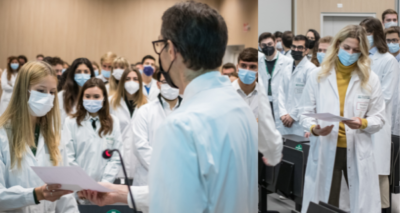The meaning of the white coat
Wearing a white coat might not appear to be a life-altering clothing choice, but it is for medical students wearing a white coat for the first time, as they start their medical training. The white coat has served as the pre-eminent symbol of physicians for over 100 years. A child’s earliest memory of a doctor is the person in the white coat, and patients expect to be treated in doctors’ offices, hospitals and clinics by an individual wearing white. Indeed, the white coat is seen as a symbol of professionalism and authority in the medical profession, and it is given to Hunimed 3rd year medical students during a ceremony at the beginning of their medical school training.
The history of the white coat
How did the white coat come to represent physicians? Physicians dressed themselves in black until the late 19th century, as black was considered formal. At the beginning of the 20th century, when medicine became the truly scientific enterprise we now know, the “whiteness” or “pureness” of medicine became reflected in the garb of physicians and nurses.
Nowadays, the White Coat Ceremony welcomes students embarking on their medical careers to the community of physicians, by giving them this powerful symbol of compassion and honour. It also gives them a standard against which they must measure their every act of care to the patients who trust them.
The white coat is a symbol of caring, trust, and professionalism that they must earn from patients. It carries a real symbolism with it: seeing someone in a white coat in the hospital signifies that you are someone who knows what is going on.
Professionalism and humanism
The focus should be on two key principles for the provision of care: professionalism and humanism, i.e. the ability to balance excellence in science with compassionate patient care. Indeed, students develop their professionalism through reflection, relationships, and resilience. At the same time, ensuring that the patient knows they are the most important thing on a physician’s mind during their meeting is humanism. By using body language and eye contact, a patient can see they are understood and cared for.

